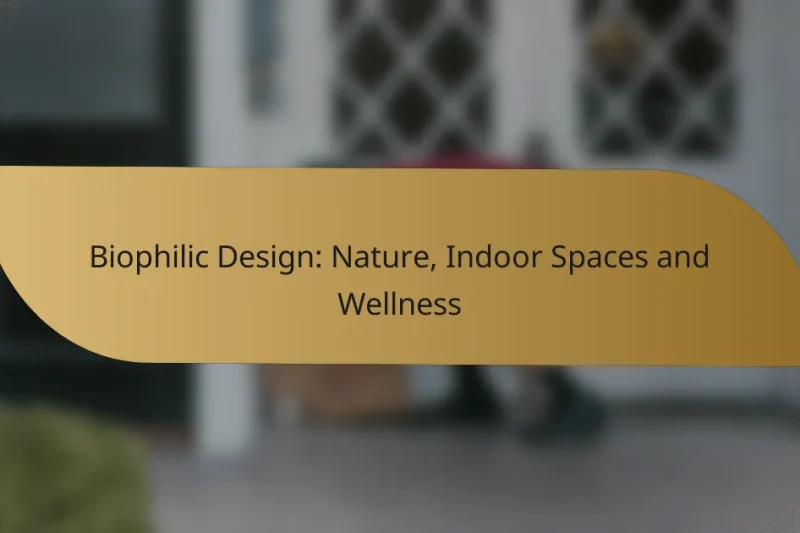In today’s interior design landscape, color trends are shifting towards a harmonious blend of natural hues … Color Trends: Palette Selection, Mood and StyleRead more
Home Decor Trends to Watch
As we step into 2024, home decor trends are shifting towards a harmonious blend of nature, simplicity, and technology. Emphasizing well-being and personal style, homeowners are increasingly opting for sustainable materials and thoughtful color palettes that enhance their living spaces while minimizing environmental impact.
Global Cultures: Influence, Aesthetics and Trends
Global cultures play a pivotal role in shaping contemporary fashion trends, infusing diverse aesthetics and design … Global Cultures: Influence, Aesthetics and TrendsRead more
Home Decor: Vintage Styles, Modern Integration
Integrating vintage styles into modern home decor creates a unique aesthetic that marries the charm of … Home Decor: Vintage Styles, Modern IntegrationRead more
Biophilic Design: Nature, Indoor Spaces and Wellness
Biophilic design is a transformative approach that integrates natural elements into indoor spaces, significantly enhancing wellness … Biophilic Design: Nature, Indoor Spaces and WellnessRead more
Home Decor Trends: Staying Informed and Ahead
Staying informed about the latest home decor trends in 2023 can help you create a space … Home Decor Trends: Staying Informed and AheadRead more
Home Decor Trends: What’s In and What’s Out
As home decor trends evolve, a focus on nature-inspired elements and earthy tones is taking center … Home Decor Trends: What’s In and What’s OutRead more
Home Decor Textures: Enhancement, Contrast and Comfort
Incorporating diverse textures into home decor can transform urban living spaces by adding depth, character, and … Home Decor Textures: Enhancement, Contrast and ComfortRead more
What are the top home decor trends in 2024?
The top home decor trends in 2024 emphasize a blend of nature, simplicity, and technology. Homeowners are increasingly seeking designs that foster well-being, reflect personal style, and integrate smart solutions for convenience.
Biophilic design
Biophilic design focuses on incorporating natural elements into interior spaces to enhance well-being. This trend includes using materials like wood and stone, as well as integrating plants and natural light to create a calming environment. Consider adding indoor gardens or large windows to bring the outdoors in.
To effectively implement biophilic design, aim for a balance between natural and artificial elements. Use earthy color palettes and textures to evoke a sense of nature, which can significantly improve mood and productivity.
Minimalist aesthetics
Minimalist aesthetics prioritize simplicity and functionality, often featuring clean lines and a restrained color palette. This trend encourages decluttering and focusing on essential pieces that serve a purpose while maintaining an elegant appearance. Think of furniture with sleek designs and neutral tones.
To embrace minimalism, consider adopting a “less is more” approach. Limit decorative items and choose multi-functional furniture to maximize space without sacrificing style. This can create a serene atmosphere that feels spacious and organized.
Bold colors and patterns
Bold colors and patterns are making a comeback, allowing homeowners to express their individuality. This trend encourages the use of vibrant hues and striking designs in furniture, textiles, and wall treatments. Consider accent walls or statement pieces that draw the eye.
When incorporating bold colors, balance them with neutral tones to avoid overwhelming the space. Use accessories like cushions or artwork to introduce patterns without committing to a complete overhaul of your decor.
Smart home integration
Smart home integration involves using technology to enhance convenience and efficiency in home decor. This trend includes smart lighting, thermostats, and security systems that can be controlled remotely. Homeowners are increasingly looking for ways to streamline their living spaces with technology.
To effectively integrate smart home solutions, start with devices that fit your lifestyle. For example, smart speakers can control music and lighting, while smart thermostats can optimize energy usage. Ensure compatibility with existing systems for a seamless experience.
Vintage and retro styles
Vintage and retro styles are gaining popularity as homeowners seek to add character and nostalgia to their spaces. This trend often features furniture and decor from past decades, creating a unique blend of old and new. Look for thrifted items or reproductions that capture the essence of a bygone era.
To incorporate vintage elements, mix and match different styles while maintaining a cohesive color scheme. Use vintage pieces as focal points in a room, and combine them with modern accessories to create an eclectic yet harmonious look.
How can I incorporate sustainable materials in home decor?
Incorporating sustainable materials in home decor involves using resources that are eco-friendly, renewable, and often recycled. This approach not only reduces environmental impact but also adds unique character to your living spaces.
Recycled materials
Recycled materials are an excellent choice for sustainable home decor. Items like reclaimed wood, recycled glass, and metal can be transformed into furniture, decor pieces, or fixtures. When selecting recycled materials, look for certifications that ensure the products meet environmental standards.
Consider using furniture made from reclaimed wood, which can be both stylish and durable. You can also find decorative items like vases or artwork crafted from recycled glass, adding a unique touch to your home.
Bamboo furniture
Bamboo furniture is a popular sustainable option due to its rapid growth and renewability. Bamboo is stronger than many hardwoods and can be used for a variety of furniture styles, from modern to traditional. When purchasing bamboo products, ensure they are sourced from responsibly managed forests.
Look for certifications such as the Forest Stewardship Council (FSC) to guarantee that the bamboo is harvested sustainably. Bamboo furniture not only enhances your decor but also contributes to a healthier planet.
Organic textiles
Organic textiles are made from natural fibers grown without harmful pesticides or synthetic fertilizers, making them a safer choice for your home. Fabrics like organic cotton, linen, and hemp are popular for upholstery, curtains, and bedding. When shopping for organic textiles, check for certifications like GOTS (Global Organic Textile Standard).
Using organic textiles can improve indoor air quality and reduce exposure to chemicals. Consider mixing organic cotton cushions with linen throws for a cozy, eco-friendly living space.
What are the best color palettes for home decor this year?
This year, the best color palettes for home decor focus on earth tones, pastel shades, and jewel tones. Each palette brings a unique aesthetic and mood, allowing homeowners to create inviting and stylish spaces.
Earth tones
Earth tones are grounded colors inspired by nature, including browns, greens, and warm neutrals. These shades create a calming atmosphere, making them ideal for living rooms and bedrooms.
To incorporate earth tones, consider using a base color like taupe or olive green for walls, then add accents with terracotta or sandy beige furniture. Pairing these colors with natural materials like wood and stone enhances the organic feel.
Pastel shades
Pastel shades, such as soft pinks, light blues, and mint greens, offer a fresh and airy vibe. These colors work well in spaces where a light, cheerful atmosphere is desired, like kitchens and nurseries.
When using pastels, balance them with white or light gray to prevent overwhelming the space. Accessories like cushions or artwork in pastel hues can easily refresh a room without major renovations.
Jewel tones
Jewel tones, including deep emerald, sapphire, and ruby, add richness and sophistication to home decor. These colors are perfect for creating dramatic focal points in dining rooms or accent walls.
To effectively use jewel tones, consider painting one wall in a bold color while keeping the other walls neutral. Incorporating metallic accents, such as gold or brass, can elevate the overall look and add elegance.
How do I choose the right furniture for my space?
Choosing the right furniture involves understanding your space, needs, and personal style. Start by assessing your room’s dimensions and how you plan to use the furniture to ensure a harmonious fit.
Measure your space
Accurate measurements are crucial when selecting furniture. Measure the length and width of your room, as well as the dimensions of doorways and hallways to ensure pieces can be moved in easily.
Consider the scale of the furniture in relation to your space. For example, a large sectional sofa may overwhelm a small living room, while a petite dining table could get lost in a spacious area. Aim for a balance that allows for comfortable movement and functionality.
Consider functionality
Think about how you will use the furniture in your space. Multi-functional pieces, such as a sofa bed or an ottoman with storage, can maximize utility, especially in smaller areas.
Evaluate your lifestyle needs. If you have children or pets, durable materials and easy-to-clean surfaces are essential. For a home office, a desk with ample storage might be a priority. Prioritize pieces that enhance your daily activities.
Match your style
Your furniture should reflect your personal style and complement your existing decor. Identify a design theme—be it modern, rustic, or eclectic—and choose pieces that align with that vision.
Consider color schemes and textures as well. Neutral tones can create a calming atmosphere, while bold colors can add vibrancy. Mixing materials, like wood and metal, can also create visual interest. Aim for a cohesive look that feels inviting and comfortable.
What are the latest technology trends in home decor?
The latest technology trends in home decor focus on smart home integration, sustainable materials, and augmented reality (AR) design tools. These innovations enhance both functionality and aesthetics, allowing homeowners to create personalized environments that are efficient and stylish.
Smart Home Integration
Smart home integration involves using devices that connect to the internet, allowing for remote control and automation of various home functions. Popular examples include smart lighting, thermostats, and security systems that can be managed through mobile apps or voice assistants.
When considering smart home technology, look for compatibility with existing systems and ease of use. Many devices are designed to work seamlessly together, enhancing overall efficiency and convenience.
Sustainable Materials
Sustainable materials in home decor focus on eco-friendly options that reduce environmental impact. This includes reclaimed wood, bamboo, and recycled metals, which are becoming increasingly popular for furniture and decor items.
Choosing sustainable materials not only benefits the planet but can also improve indoor air quality. Look for certifications like FSC (Forest Stewardship Council) for wood products to ensure responsible sourcing.
Augmented Reality (AR) Design Tools
Augmented reality design tools allow homeowners to visualize how decor items will look in their space before making a purchase. Apps that utilize AR can superimpose furniture and decor onto a live view of your room, helping to make informed decisions.
When using AR tools, ensure your device is compatible and has a good camera for accurate visualization. This technology can save time and reduce the likelihood of buyer’s remorse by allowing you to see how items fit into your existing decor.






